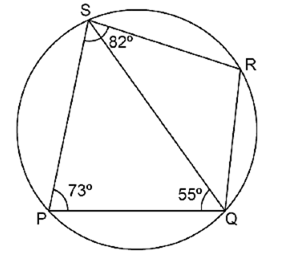The 4th term of an A.P. is 22 and 15th term is 66. Find the first term and the common difference. Hence find the sum of the series to 8 terms.
Let 'a' be the first term and 'd' be the common difference of given A.P.
Now,
4th term = 22
a + 3 d = 22 ............( i )
15th term = 66
a + 14 d = 66 ............( ii )
Subtracting ( i ) from ( ii ), we have
11 d = 44
d = 4
Substituting the value of 'd' in ( i ), we get
a = 22 - 3 x 4
= 22 - 12
= 10
First term = 10.
Now,
If (k – 3), (2k + l) and (4k + 3) are three consecutive terms of an A.P., find the value of k.
( k - 3 ), ( 2 k + 1 ) and ( 4 k + 3 ) are three consecutive terms of an A.P.
2 ( 2 k + 1 ) = ( k - 3 ) + ( 4 k + 3 )
PQRS is a cyclic quadrilateral. Given ∠QPS = 73°, ∠PQS = 55° and ∠PSR = 82°,
calculate:
(i) ∠QRS
(ii) ∠RQS
(iii) ∠PRQ

Given: PQRS is cyclic quadrilateral.
( i ) Opposite angle of a cyclic quadrilateral are supplementary.
( ii ) Opposite angle of a cyclic quadrilateral are supplementary.
( iii ) In , by angle sum property, we have
